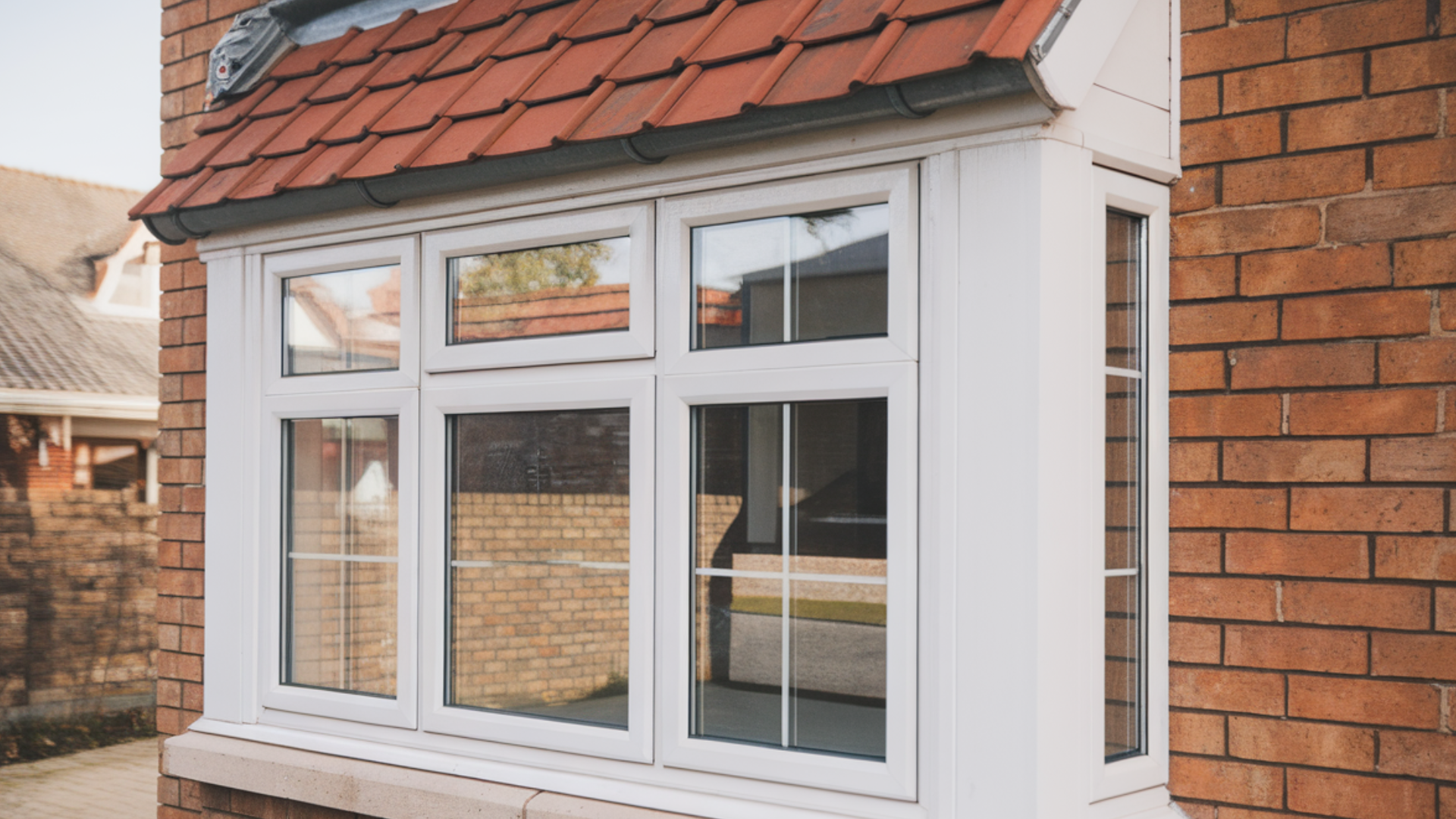Are new windows giving you a headache? Shopping for windows can feel like decoding a foreign language.
You’re standing in the store, staring at labels with weird acronyms like U-Factor and SHGC, thinking that you’ve accidentally wandered into a science lab. Sound familiar?
These technical terms might seem complicated, but they’re actually your secret weapon for choosing windows that save money and make your home more comfortable.
In this guide, I’ll break down the most important window ratings in plain English. You’ll learn exactly what U-Factor, Solar Heat Gain Coefficient, and Visible Transmittance mean.
And how they impact your energy bills, indoor temperature, and natural light. By the end of this article, you’ll be a window rating expert, ready to make a smart choice for your home.
What Are Window Ratings and Why Do They Matter?

Imagine window ratings as a report card for your windows. Just like a student’s grades show how well they’re performing in school, window ratings tell you how well a window performs in your home.
The National Fenestration Rating Council (NFRC) created these ratings to help you make smart choices. Think of them as a translator between technical specs and real-life comfort.
Why should you care? Window ratings impact three crucial things in your home:
- Energy Bills: Good ratings can help you save money
- Home Comfort: They control how the temperature feels inside
- Natural Light: They determine how much sunlight enters
When I first heard terms like U-Factor and Solar Heat Gain Coefficient, my eyes glazed over. Sounds complicated, right? But these ratings are actually your secret weapon.
The NFRC does the hard work of testing windows.
They measure how windows handle heat, block sunlight, and prevent air leaks. It’s like having a detective investigate your windows’ performance.
Bottom line: These ratings help you pick windows that work best for your specific home and climate. No more guessing game. Just smart, informed decisions that keep you comfortable and save you money.
Understanding U-Factor: How It Measures Insulation
Let’s talk about U-Factor – the window world’s secret superhero of warmth. Think of it like a thermal blanket for your entire house.
U-Factor measures how well a window stops heat from escaping.
The lower the number, the better your window is at keeping warmth inside. It’s like having a guard that prevents heat from sneaking out through your windows.
- Low U-Factor: More heat stays inside
- High U-Factor: Heat escapes easily
When I lived in Minnesota, I learned this lesson the hard way. My old windows were like open doors during winter, letting precious heat vanish. Not fun when it’s -20 degrees outside!
Imagine you’re wearing a thin jacket in a snowstorm versus a thick winter coat. That’s exactly how U-Factor works for windows.
A window with a low U-Factor (around 0.20-0.30) is like that thick winter coat, keeping your home cozy and warm.
Pro Tip: If you live in cold regions, look for windows with the lowest U-Factor you can afford. Your heating bill will thank you.
Typical U-Factor ranges are:
- Cold Climates: 0.20 – 0.30
- Moderate Climates: 0.30 – 0.50
- Hot Climates: 0.50 – 0.75
Bottom line? U-Factor isn’t just a number. It’s your home’s defense against winter’s chill.
Solar Heat Gain Coefficient (SHGC): What It Tells You
Ever felt like your house turns into an oven during summer? That’s where SHGC comes to the rescue. What is Solar Heat Gain Coefficient?
SHGC measures how much sun heat sneaks through your windows.
Think of it like sunscreen for your house. A lower number means less heat enters, making it perfect for keeping things cool.
How it works:
- Low SHGC (0.30 or less): Blocks most sun heat
- High SHGC (0.60 or more): Let more sun warmth inside
When I moved to Texas, I quickly learned why SHGC matters. My west-facing windows turned my living room into a literal heat trap. Not cool – literally!
In hot regions like Arizona or Florida, you want windows that block the sun’s heat. It’s like having an invisible shield against summer’s intensity.
But if you’re in Minnesota? Those same windows might help warm your home during winter. Imagine your windows as sunglasses for your house:
- Hot Climate: Dark, heavy-duty sunglasses (low SHGC)
- Cold Climate: Light, transparent sunglasses (higher SHGC)
Pro Tip: Check which direction your windows face. South-facing windows get the most sun, so SHGC becomes super important.
The goal? Keep your home comfortable without breaking the bank on cooling or heating.
Visible Transmittance (VT): How Much Light Gets Through
Let’s talk about the sunshine meter for your windows – Visible Transmittance, or VT for short.
VT measures how much natural light slides through your window glass. It’s like a brightness rating that tells you exactly how much daylight will flood your rooms.
- Low VT (0.2-0.4): Dimmer rooms
- High VT (0.6-0.8): Bright, sunny spaces
When I replaced my basement windows, I realized how much VT matters. Suddenly, my dark space transformed into a light-filled room without adding extra lamps.
Natural light isn’t just pretty – it’s practical. More sunlight means:
- Lower electricity bills
- Happier mood
- Less need for artificial lighting
Here’s the tricky part: you want enough light without turning your room into a greenhouse. Some windows come with special coatings that let light in while blocking heat.
Pro Tip: Consider your room’s purpose. Home office? You might want higher VT. TV room? Maybe tone it down.
Imagine VT like sunglasses for your house. Some block everything, some let everything through.
The perfect pair lets just enough light pass. Your goal? Find windows that make your space feel bright and welcoming without causing glare or overheating.
Other Important Window Ratings to Know
Think of these additional ratings as bonus features on your window’s performance report card. They’re not the main stars, but they can make a big difference.
1. Air Leakage (AL): The Draft Detective
Air Leakage tells you how much wind sneaks through your window’s tiny cracks. Lower numbers mean fewer drafts.
Imagine sitting near a window and feeling cold air whisper against your skin – that’s high air leakage in action. A good window keeps those sneaky breezes outside where they belong.
2. Condensation Resistance: Fog Fighter
Ever seen your windows turn into a misty mess during cold mornings? Condensation Resistance helps prevent that.
It’s like a built-in defogging system that keeps your view clear. The higher the rating, the less likely your windows will look like they’ve been crying.
3. Design Pressure (DP): Wind and Storm Shield
This rating shows how much wind and pressure your window can handle. It’s super important in areas with hurricane or storm risks.
Think of DP like a window’s muscle strength – how much beating can it take before giving up?
Don’t get overwhelmed. You don’t need to be an expert on every single rating.
Focus on the big three (U-Factor, SHGC, and VT) and use these extra ratings as helpful tie-breakers when choosing windows.
Your windows are more than just glass. They’re your home’s guardians against temperature, light, and weather. Understanding these ratings helps you pick the right defenders.
What Does This Mean for Homeowners?
Window shopping isn’t about finding the “perfect” window. It’s about finding the right window for your home.
Your local climate is the ultimate deciding factor. Living in Phoenix? You’ll want different windows than someone in Minnesota. It’s like choosing different clothes for different weather.
- Hot Regions: Low SHGC, good air sealing
- Cold Regions: Low U-Factor, higher SHGC
- Mixed Climates: Balanced ratings
When I bought my first home, I made mistakes. I chose windows that looked great but performed terribly. Learn from my experience: performance trumps appearance.
- Check your climate zone
- Look for Energy Star labels
- Compare ratings side-by-side
- Ask local experts about regional recommendations
The Energy Star label is your quick-and-easy quality guarantee. It’s like a trusted friend saying, “These windows are legit.”
Don’t chase perfection. Aim for the best balance of comfort, efficiency, and cost. Your wallet and your indoor temperature will thank you.
Remember: Good windows are an investment. They protect your home, save energy, and create comfort. Take your time. Research. Ask questions.
Your dream windows are out there – waiting to make your home more awesome.
Conclusion
Window ratings might seem like a foreign language, but they’re actually your secret weapon.
By spending just a few minutes understanding U-Factor, SHGC, and VT, you can save hundreds of dollars on your energy bills and create a more comfortable home.
And this is the best part: You don’t need a science degree. Just basic knowledge to ask smart questions. When shopping, remember these ratings are tools, not tests.
They help you make informed choices that protect your home and wallet. Confidence is key, so walk into that window store knowing exactly what to look for.
Ask about Energy Star ratings, compare numbers, and trust your new knowledge.
Your home deserves windows that work as hard as you do.








